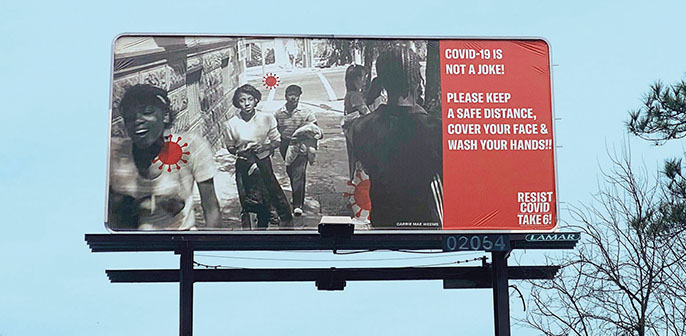
Honorary Southern Photographer Carrie Mae Weems (see image above) is having a major show of her work in Durham, NC, made possible by Duke University's Nasher Museum. Weems' work is visible all over Durham, on billboards in a lot of locations.
Marshall Price, the Nancy A. Nasher and David J. Haemisegger Curator of modern and contemporary art at the Nasher explains:
“It kind of fell in our laps,” he says. Artist and MacArthur grant-winner Carrie Mae Weems, a Black woman whose art is in the Nasher’s collection and who has collaborated before with the museum, had created an outdoor public art installation during a Syracuse residency, and she was spreading it out to museums in places like Philadelphia, Chicago, and Nashville, Tennessee. Did the Nasher want to participate?
“We felt like it was a really great opportunity,” Price says. “We kind of rolled up our sleeves and got to work.”
"Weems’ work, called Resist Covid/Take 6!, exists completely outdoors, largely as public-service announcements and statements of encouragement about surviving COVID. “Don’t worry, we’ll hold hands again,” reads the caption of an enormous banner hanging on the outside of the Nasher, showing a row of people holding hands. Says one of a series of banners on Campus Drive lampposts: “Because of inequity, Black, Brown & Native people have been the most impacted by COVID-19. This must be changed!” Other banners and window clings thank frontline workers and remind people to practice social distancing. They show up on building sides and in windows all over Duke—on the Rubenstein Arts Center, on the gates to the (currently closed) Duke Gardens.
"The signs show up all over Durham, too, from billboards to the windows of community partners like the American Dance Festival headquarters. Part of Weems’ design of the installation was that community collaboration. “It functions in that context just as much as a public-service announcement as art,” Price says. None of the posters have Duke or Nasher branding. The point is to get people talking about how to respond to COVID; how it’s affecting them and their community; how Black, brown, and native populations are being especially hard hit."
The above quotes are from a story in the Duke Alumni Magazine; read more if you go here:
https://alumni.duke.edu/magazine/articles/art-nasher-time-covid














